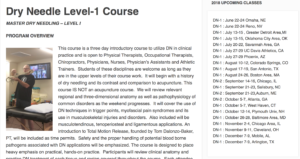by Mitch Hauschildt, MA, ATC, CSCS
Last weekend I had the opportunity to be the student instead of the instructor, which was a nice change for me. I love to learn and I really wish that my schedule would allow me to take more courses than I do, but with my family, full time job and teaching schedule, there just aren’t many days left on the calendar to be traveling to take courses, so I work hard to continue my learning in other ways. But, I found a way to make it work for me to get to a course.
This weekend I had the opportunity to finally explore the world of dry needling for myself. I have wanted to take a dry needling course for 4-5 years and have been needled myself several times, but for a host of reasons (state licensure laws, cost, time, etc), I just now registered for a course this past weekend and got certified.
There are a lot of course options out there regarding dry needling (and growing every day) and they each have their own structure and advantages and disadvantages. I would love to say that I heavily researched this specific course to pick the organization and type of dry needling that I wanted to learn, but honestly, this course fit into my schedule and the location was such that I could bring my family with me and combine work with family time, which is a huge win for me. So I signed up for it not knowing for sure how great the course was going to be.
The one thing that I did know was that Master Dry Needling is put on by the folks at Total Motion Release (TMR). I have used some of their concepts on and off for years, so I at least felt as if I was getting certified for a reputable organization. Beyond that, all I knew was that it was a 3 day course that involved long days and lots of content.
Master Dry Needling offers both level 1 and level 2 courses. This weekend was a level 1 course, but offered a lot more techniques as compared to other organizations that I have researched because the course was 27 hours long over the 3 days. That’s a lot of time to be sitting in class, but personally, if I’m going to be there, I would prefer to cram as much in as possible.
The course instructor was Scott Dixon, DPT, out of Atlanta. It was very clear from the start that Scott knows how to dry needle. He uses them every day in his private practice and had a wealth of knowledge regarding different techniques, approaches, body types, and styles of therapy. Scott was laid back, fun, energetic and very approachable. He clearly loves to help people improve their skills and he is a guy that I hope I can keep in contact with in the future for a number of reasons.
At times during the course I found myself looking for a little bit more in depth and organized lectures to make me feel 100% percent comfortable with the science, approach, history and specifics of dry needling. But, where things may have been a little weak in the didactic portion of the course from time to time, they definitely made up for it in the hands on lab sessions.
I would guess that I personally inserted close to 150 needles into other people over the 3 day period and Scott gave us plenty of time and opportunity to make sure that we were beyond comfortable with the various techniques that were taught in the course.
Something that I really enjoyed about the course is that it really seemed to be a great combination of treatment approaches, all in one course. Some dry needling courses are narrowly focused on trigger point needling to reduce trigger points that often exist in muscle bellies. Other organizations are much more systemic in nature, only looking at placing needles along specific treatment meridians. Still other courses won’t allow you to go near the thorax in a level 1 course due to various risk factors which ultimately leaves you with a limited teaching approach.
The Master Dry Needling course educated us on all of these approaches. We definitely performed trigger point dry needling when appropriate. We also learned how to treat various areas of the body at the same time in an effort to take a more systemic approach to our treatment. And, we were educated on the risks and rewards regarding using needles on different areas of the body and were informed on how to perform dry needling safely throughout the entire chain.
I also enjoyed this course because Scott did a nice job of teaching how dry needling fits into an overall treatment plan with other modalities such as cupping, taping, IASTM and exercise. Scott is also a big fan of the FMS and SFMA approach, just as I am, so we were able to communicate in those terms. I feel very comfortable plugging dry needling into my treatments right away.
Overall, I would recommend taking this course if you are interested in a good entry level dry needling course that will get you performing this game changing modality. It is still a fairly new course for this company, so I think that some areas will continue to be refined over time for the better, but I enjoyed the weekend, I feel very comfortable using needles right away, and at less than $1000, it is an affordable course as compared to other similar seminars on the open market.
If you aren’t needling and it is allowed in your state practice act, I highly recommend that you take a course and get going it. It is a game changer!


Leave a Reply